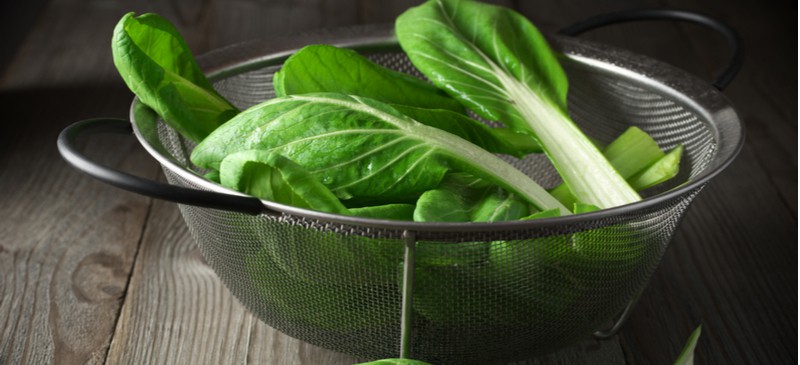
If you’re a fan of mustard greens, cabbage and spinach, you’ll probably love the taste and texture of tatsoi, a Chinese cabbage with a unique taste and impressive nutrition profile.
This ancient green is an excellent source of micronutrients and is as versatile as popular leafy greens. It has even been nicknamed “vitamin green.”
To mix up your standard salad greens, consider giving tatsoi a try. The leaves offer a mustardy taste and can spice up any plain ol’ dish.
What Is Tatsoi?
Tatsoi is a leafy green in the Brassica family, along with mustard greens. Also called “tat choy,” this Asian green is closely related to bok choy, and it’s gaining popularity in North American cuisine because of its unique flavor and nutrition content.
This Chinese cabbage has spoon-shaped leaves with a sweet but nutty flavor when eaten raw.
Many liken the taste and texture of tatsoi greens to spinach and Swiss chard. The leaves can be consumed raw and added to salads or lightly cooked and added to soups and stir-fries.
Types/Varieties
Tatsoi is a type of Chinese cabbage, and it also goes by the names:
- tat soy
- tat soi
- spoon mustard
- spinach mustard
- broadbeak mustard
- rosette bok choy
When shopping for plants or seeds, they’ll likely be labeled “tatsoi,” but there are other speciality varieties available, some of which are labeled as bok choy seedlings. They include:
- Black Summer
- Joi Choi
- Ching-Chiang
- Win Win Choi
- Mei Qing Choi
Nutrition
You know how you can tell that tatsoi is a nutrient powerhouse? Compare its contents to those of bok choy, and it has higher amounts of vitamin A, vitamin C, calcium and iron.
The nutrition value of these Asian greens may vary, depending on when they are harvested and the type of seedlings used. Generally, 100 grams of raw tatsoi leaves contain approximately:
- 22 calories
- 3.9 grams carbohydrates
- 2.2 grams protein
- 0.3 grams fat
- 2.8 grams fiber
- 130 milligrams vitamin C (0ver 100 percent DV)
- 9,900 international units vitamin A (over 100 percent DV)
- 159 micrograms folate (40 percent DV)
- 210 milligrams calcium (21 percent DV)
- 449 milligrams potassium (13 percent DV)
- 1.5 milligrams iron (8 percent DV)
- 0.15 milligrams vitamin B6 (8 percent DV)
- 0.09 milligrams vitamin B2 (5 percent DV)
- 0.06 milligrams thiamin (5 percent DV)
- 11 milligrams magnesium (3 percent DV)
Benefits
The potential health benefits of tatsoi come from the plant’s antioxidant and micronutrient content. Called “vitamin green,” it’s one of the top food sources of vitamin C and vitamin A.
1. Rich in Vitamin C
Tatsoi offers more vitamin C than oranges, papaya and spinach. These greens are packed with disease-fighting antioxidants that minimize oxidative stress and damage to your cells.
Research shows that eating vitamin C foods may be associated with a lower risk of many chronic conditions, including heart disease, stroke and cancer. Getting plenty of vitamin C is also known to increase longevity.
2. Excellent Source of Vitamin A
Asian greens are an excellent source of vitamin A, a nutrient that plays an important role in many body functions. Vitamin A helps maintain strong bones, healthy skin and a strong immune system.
It’s also critical for vision support and has been shown to help in the prevention of macular degeneration.
3. Provides Folate
Want to promote brain, heart and bone health? Make sure you get enough folic acid foods in your diet. Adding tatsoi is a great way to boost folate levels, which support strong bones, cognitive function and even a healthy pregnancy.
READ RELATED: Are Ghee Benefits Better Than Butter?
Studies indicate that high folate intake is associated with a reduced risk of Alzheimer’s disease and may help boost brain function for elderly adults experiencing cognitive decline.
4. Features Glucosinolates
Glucosinolates are compounds found in cruciferous vegetables. They give greens their bitter taste and have been researched for their protective benefits against heart disease, cancer and more.
Research suggests that glucosinolates have anti-carcinogenic effects and may reduce the risk of certain cancers, including breast, kidney and esophageal cancers.
5. Improves Heart Health
Asian greens are packed with heart-healthy nutrients, including antioxidants and calcium. Adding these greens into your diet can help boost heart health by relaxing smooth muscle tissues in your arteries and helping prevent blood clotting.
Studies show that it’s important to obtain calcium from your diet, so eating foods rich in the nutrient will help you to maintain healthy levels and not only improve heart health, but benefit bone health too.
How to Grow
Tatsoi greens can be planted in the spring for a summer harvest or in the late summer for fall harvest. They grow quickly, in about 20 days, and make an excellent addition to your home vegetable garden.
If you plan to plant it in the spring, opt for full-grown tatsoi instead of seedlings, which would be more vulnerable in cold temperatures.
The best growing conditions for mustard spinach include:
- Plant tatsoi in an area that gets three to four hours of sun each day.
- Use well-draining soil.
- Water the greens regularly.
- Ideal temperatures for growing these greens are between 60 and 70 degrees Fahrenheit.
Harvesting the leaves is simple. You can start cutting leaves when they are about four inches long. To cut the whole head of the plant, leave about one inch above the ground so it re-sprouts.
How to Use (Recipes)
You can use tatsoi in the same ways you use spinach, arugula and mustard greens. It goes well in salads and as a side in seafood or meat dishes.
It has a mild earthy flavor with peppery, mustardy notes, so it pairs well with sweet ingredients like apples and citrus fruits.
The greens have a pleasant buttery texture when added to stir-fries and cooked with vegetables. When eaten raw, they offer a nice crunch.
When shopping for Asian greens, look for leaves that have a glossy green color. Avoid leaves that are yellow and wilting.
The freshest form of mustard spinach will be offered as an intact head, which you may find at your local farmers market. Greens can be stored in the refrigerator for three to five days.
Need some ideas for tatsoi recipes? Try these simple and healthy dishes:
- Tatsoi stir-fry with carrots, shallot and warming spices, such as cumin, ginger and pepper
- Green salad with tatsoi, cucumber, carrots and a sesame-ginger dressing
- Tatsoi greens with sliced pears, chopped pecans and dressing made with honey, vinegar and olive oil
- Soup with Asian greens, sweet potato, chickpeas, celery and warming spices
Risks and Side Effects
Like bok choy, tatsoi is referred to as a “goitrogenic,” which means that it contains chemicals that may interfere with the production of thyroid hormones. If you have thyroid issues, speak to your doctor before adding Asian greens to your diet.
Conclusion
- Tatsoi is a plant in the Brassica family that’s closely related to bok choy. The greens are known for their unique taste and impressive nutrition profile.
- The leaves of the plant are loaded with vitamin C, vitamin A, calcium and folate. They are great sources of antioxidants and help fight disease, while boosting cognitive and heart health.
- You can buy tatsoi leaves at many health food stores or farmers markets. You can also easily grow your own and add them to salads, soups, stir-fries and more.
Source: Dr. Axe | Nutrition





